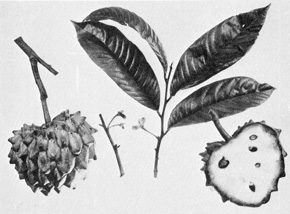|
Common names: wild custard apple (English); abo (Nigeria). Origin: West Africa. Distribution: Tropical Africa. Cultural requirements: Grows in poor soils in low moist areas in hot tropical climates. Description: Tree to 6 m. Propagation by seed. Flowers February-April. Fruit matures in 120 days. Fruit 5 cm in diameter, solitary, yellow exterior. Utilization: Pulp eaten fresh. Flavor sweet; limited appeal. Little potential as a food crop. References: Dalziel 1948, Irvine 1961. Annona squamosa L. Common names: sugar apple, sweetsop (English); anon, rinon, anona blanca (Spanish); attier, anone écaillouse (French); ata, fruta de condessa (Portuguese). Origin: Tropical America. Distribution: Pantropic. Cultural requirements: Hot tropical lowlands or sub-tropical climate, with medium rainfall. Will survive light frost. Description: Tree to 6 m. Propagation by seed, graft-ing. Fruit production in 3-5 years from seed, 2-3 years from grafts. Flowers in April-May (Florida). Fruit matures in 120-150 days. Fruit ovoid, 5-10 cm in diameter, solitary; external color green, internal white. Utilization: Pulp eaten fresh, in ice cream, sherbets, other desserts. Flavor sweet, good; general appeal. Moderate levels of vitamin C. Good poten-tial for home garden and limited commerical production. References: Fouqué 1974, Popenoe 1939, Ruehle et al. 1958. Annona squamosa x A. cherimola (hybrid). Common name: atemoya (English). Origin: U.S.A. (Florida). Distribution: Tropics, subtropics. Cultural requirements: Warm tropical or subtropical climate. Tolerant of a variety of climatic and soil conditions and of light frost. Description: Tree to 6 m. Propagation by seed, graft-ing. Fruit production in 4-5 years from seed, 2-3 years from grafts. Flowers April-June (Florida), sometimes two blooms a year. Some varieties need hand-pollination for good production. Fruit matures in 150-180 days. Fruit 8-15 cm in diam-eter, 300-900 g or more, solitary; external color green, interior white. |
Utilization: Pulp
eaten fresh, in sherbets, other desserts. Flavor sweet, excellent; universal
appeal. Great potential for commercial production in tropical and subtropical
lowlands. Variety improvement, cultural research in Israel, South Africa,
Australia, U.S.A. (Florida). Reference: Campbell and Phillips 1980. Rollinia deliciosa Saff. (= R. pulchrinervis DC.) Common names: biriba (English); biriba, fruta da condessa (Portuguese). Origin: Brazil. Distribution: Brazil; introduced elsewhere into Tropics but rare. Cultural requirements: Hot, humid tropical lowlands. Very susceptible to frost injury. Description: Tree to 10 m. Propagation by seed. Flowers April-May (Florida). Fruit matures in 90 or more days. Fruit 8-12 cm in diameter, solitary; external color yellow, internal white. Utilization: Pulp eaten fresh, as juice, in desserts. Flavor sweet, pleasant; good acceptance. Fair potential as crop in humid Tropics. References: Fouqué 1974, Popenoe 1939. Rollinia mucosa Baill. Common names: wild sweetsop (English); anon cimarron (Spanish); cachiman crème, cachiman morveux (French); araticum pitaia, condessa (Portuguese). Origin: Central and South America, West Indies. Distribution: Tropical America. Cultural requirements: Hot, humid tropical lowlands. Description: Tree to 10 m. Propagation by seed. Flowers April-May (Florida). Fruit matures in 90 or 
Figure 13. Rollinia mucosa, a very good annonacious fruit. |